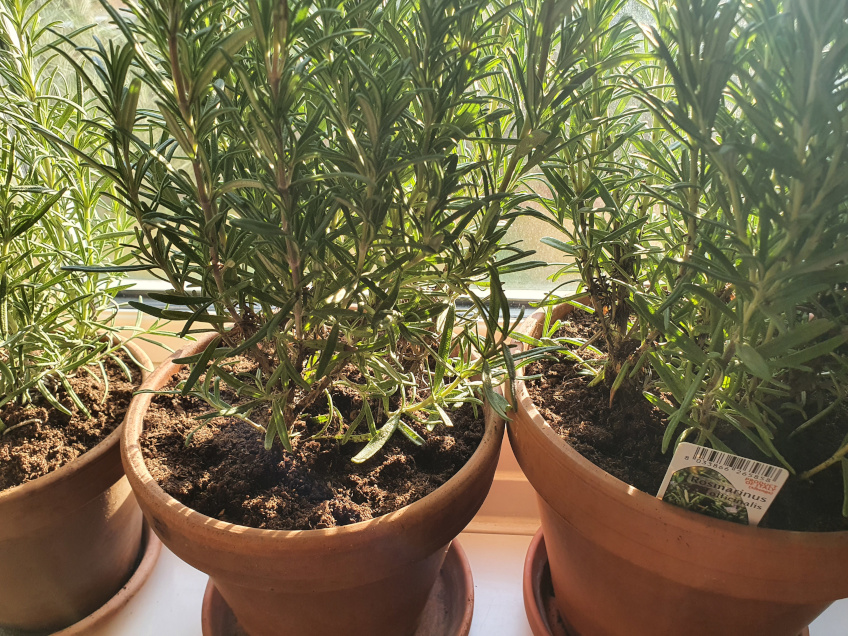
When you give rosemary the right growing conditions when it comes to sunlight, temperature, watering, fertilizing, and soil, it will reward you by growing and producing fast and efficiently, eventually allowing you to harvest almost endless amounts of rosemary while the plant continues to grow better and better.
Native to the Mediterranean, rosemary likes warm temperatures and high amounts of direct sunlight, and while it is a sturdy plant that can grow in many places, giving rosemary the optimal conditions can increase the plant’s health and rate of growth and production as well as improve the aesthetics of the plant.
In this post, you will learn how you can give your rosemary the ideal conditions for growing so you can eventually have a plant that provides you with endless supplies while continuing to grow. I also give some suggestions for what you can do if you live in a place where meeting these conditions can be difficult.
If you just want some quick facts, here is a small table I made to give you a quick and easy overview of what the best conditions for rosemary are when it comes to sunlight, temperature, watering, fertilizing, and soil.
| Direct sunlight | At least 6-8 hours per day |
| Temperature | 68-86 F (20-30 C) |
| Watering | In a pot: Weekly In the ground: Every 2 weeks at most |
| Fertilizer | Every 1-2 months or never |
| Soil | Loam (40% sand). Slightly acidic (6-7 pH) |
Below, I go into more detail with each of the areas from the table above and come with some tips on how you can improve the conditions for your rosemary when it comes to sunlight, temperature, watering, fertilizing, and soil.

1. Sunlight: 6-8 Hours of Direct sunlight per Day
Like most plants that are native to the Mediterranean region, rosemary grows best when it is exposed to a lot of direct sunlight.
Rosemary should ideally get between 6-8 hours of direct sunlight per day to grow well. It can grow in partial sunlight, but it grows better when exposed to full sun. If rosemary is growing in partial sunlight, it needs more light to absorb enough energy compared to if it grows in direct sunlight.
Rosemary definitely grows best outdoors where it can get lots of direct sunlight, but you can actually also grow rosemary very well indoors.
I have grown rosemary indoors for a long time and in my experience, it grows well and can even survive over the winter even though it does not get much (if any) sunlight most days. During the winter, however, it grows much slower than during the summer since there is not much sunlight to provide it with energy.
If you are growing rosemary indoors in a pot of a container, it is best to place it in a spot where it can get as much sunlight as possible such as next to a south-facing window. As the months go by and the direction the light comes from changes, move the pot or container around to maximize the sunlight your rosemary gets.
2. Temperature: Between 68-86°F (20-30°C)
As a Mediterranean native, rosemary does not only like direct sunlight but also high temperatures.
The best temperature for growing rosemary is between 68-86°F (20-30°C). These high temperatures encourage rosemary to grow and produce faster than it would at lower temperatures.
Rosemary is a perennial in most parts of the world where the winters are not too intense. Large, well-established rosemary bushes are of course sturdier than young, small plants and while large and well-established rosemary bushes can actually survive a bit of night frost, younger and smaller plants might not be able to.
Older rosemary bushes will usually be just fine at temperatures down to about 30°F (-1°C) in the winter but if the temperature dips below that, it can be a good idea to cover your plant at night to prevent it from getting too cold since that can damage the plant.
3. Watering: Once per Week or Less
As with almost anything when it comes to gardening, how much water rosemary needs depend on several things.
A good rule of thumb for watering rosemary in a pot is to water it about once per week or when the top inch of the soil is dry. Large and well-established rosemary plants that grow in the ground may not ever need watering, but small, young rosemary plants usually need watering every 1-2 weeks.
How you should water rosemary that grows in the ground depends largely on the size of the plant and where you live. If you live in an area that experiences long periods of drought, you may want to water your rosemary bush every two weeks or so. If you live in an area that has rain around once per week or two, you probably don’t need to water it.
The reason why larger plants that grow directly in the ground may not ever need watering is that they usually have large root systems that can seek out water from the ground.
Smaller rosemary plants need more frequent watering than larger plants but in smaller doses. This is primarily because smaller plants have smaller root systems that cannot obtain water as fast as larger plants and since rosemary is subject to root rot, it should not be overwatered.
I have a complete guide where I explain how to water rosemary on this link. I explain how much and how often you need to water your specific rosemary plant based on several factors as well as a bunch of other excellent tips that can help your rosemary thrive.
4. Fertilizer: Once per Month or Never
Rosemary does not need much fertilizer at all. If any.
As a general rule, rosemary does not need fertilizer. Instead, a better way of giving rosemary nutrients is by adding compost as topsoil around the plant every 1-2 years. If some of the leaves are turning yellow, it can, however, be beneficial to give the plant a small amount of fertilizer.
Be careful if you give your rosemary fertilizer. When it comes to rosemary, it is always better to not use any fertilizer than too much. Of course, this is true for all plants but in my experience, it is especially relevant for rosemary since it really does not need much and usually gets enough from the soil it grows in.
I never fertilize my rosemary more than once every 1-2 months at most.
5. Soil: Loose and Slightly Acidic With a pH of 6-7
When it comes to soil, rosemary is not super picky but there are some things you should avoid.
The most important thing, in my experience, is that you don’t use too nutrient-rich soil for your rosemary as it might cause the plant to become overfertilized and some of the foliage to get scorched. You also shouldn’t use soil with a high content of clay as it retains water for too long.
The best soil for rosemary to grow in seems to be loose soil without too much compost or organic matter. The soil should be slightly acidic with a pH between 6-7.

